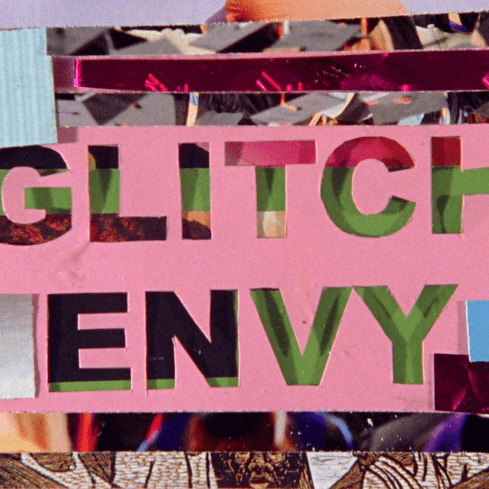Mark Williams (MW): Welcome to Aotearoa New Zealand! What brings you to our fair shores?
Jodie Mack, Fern Silva (JM&FS): Jodie will be leading a workshop at the Govett Brewster Gallery as part of her Projection Series running concurrently for the FREE RADICALS show. Fern will be shooting for his latest film.
MW: Your upcoming programme at the Pyramid Club combines works by both of you into a single screening. How do you think your practices differ and what are the overlapping concerns? What can we expect to see?
JM&FS: Respectively, our films chart human consumption of landscape and production of objects in relation to an increasingly globalized identity. While our main influences stem from experimental film and installation traditions, we also seek inspiration from pop culture: top 40 radio, Hollywood Film, commercials. The subjects of our films have spanned from planned obsolescence to e-commerce, to the Florida Everglades and the coexistence of sacred land and scientific exploration.
MW: Fern—your works are often described as having a relationship to ethnography. How well do you have to know a subject before you feel confident enough to shoot—or do work more intuitively and assemble your work in the edit room?
FS: It's definitely both, there's all sorts of research that's done beforehand in order to familiarise myself with a particular location or situation. The planned production aspect of making a film is balanced with an intuitive approach, allowing action to unfold while considering framing devices and other techniques that I can connect in the edit room, even sometimes editing in-camera. With that said, I do allow myself space to incorporate all aspects of production while on location, well knowing that you never really learn enough about a place until you're there.
MW: Jodie—a lot of your work seems to be about working through images that exist in the world already, be they textiles, magazine clippings or newspaper. Why rework these specifically through the medium of 16mm film?
JM: 16mm film is simply my tool, much like if I played the piano or made pictures with pencils. The material renders colour and texture in a way much suited to the objects I film; the projection mechanism suits the illusion of apparent motion; and the filmstrip renders a temporal archive of objects for each individual film.
MW: Apart from the combined screening programme, how does collaboration inform your work?
JM&FS: For over six years, we have served as parallel sounding boards, inspirers, and co-conspirator in each other’s films. We are also members of LIGHT CLUB (formerly Colony of Light), a group formed in 2013 at MoMA PS1 during EXPO 1. Starting out by living together in a museum courtyard in a caravan of airstream trailers, the group began shooting film, constructed a darkroom in a museum bathroom, and started an ongoing collaborative project. We have met in seminar form one to two times a year since this first meeting, amassing hours of footage, sound recordings, and photographs. Currently we are entwined into each other’s solo feature film projects. Jodie is currently editing an animated feature, The Grand Bizarre, for which Fern has been a large part of the development and production and for which he is currently serving as editing and sound supervisor. Fern is currently shooting a live-action feature, Sacred Sights, for which Jodie has been a large part of the development and production and is currently the producer.
MW: How important is it for you both to be present when the works are shown?
JM: For me, it can vary. I have a collection of films designed for live performance where my presence plays an important role, but many of my films screen without me all the time. I think the importance of the filmmaker being present to engage with the audience is one of the most special aspects of experimental film—one to be treasured. I learn a lot about my films and filmmaking in general from watching these sessions unfold or by being out on the spot for my own works.
MW: Recently CIRCUIT showed a bunch of NZ cinema work in Europe, working in a contemporary gallery, a cinema co-op and a film festival. What kind of context do you feel has been the most supportive and interesting for you to show yr work thus far? Can you think of a particular instance where the context has affected the work in a particularly inspiring or insightful way?
FM: I think they've all been supportive and interesting for the most part but the act of cinema is something I personally enjoy most so I'd say that's where I direct most of my energy in making and sharing. With that said, framing for a large projection, on film, in a dark room with a captive audience seems to be one of the most magical experiences a person can have, especially this day and age, together, watching a world unfold within a fraction of time.
MW: NZ has a building dedicated to Len Lye but otherwise there is still a sketchy sense of history here (even though the practice of experimental film/video art/artist moving image making in this country goes back many decades). In the States there are so many celebrated elders, what kind of connection do you feel to established practitioners, be they in film, art or art generally?
JM: I think we both continue certain geographic or pedagogical lineages in our work—me from Florida and Chicago and Fern from Massachusetts and New York.
FS: I agree, we've been so fortunate to have kind and generous peers and mentors who've helped unlock all sorts of potential of creative self expression within the worlds of art and cinema.
Thanks to the Govett Brewster Art Gallery/Len Lye Centre for their support of Jodie Mack’s visit to New Zealand.
